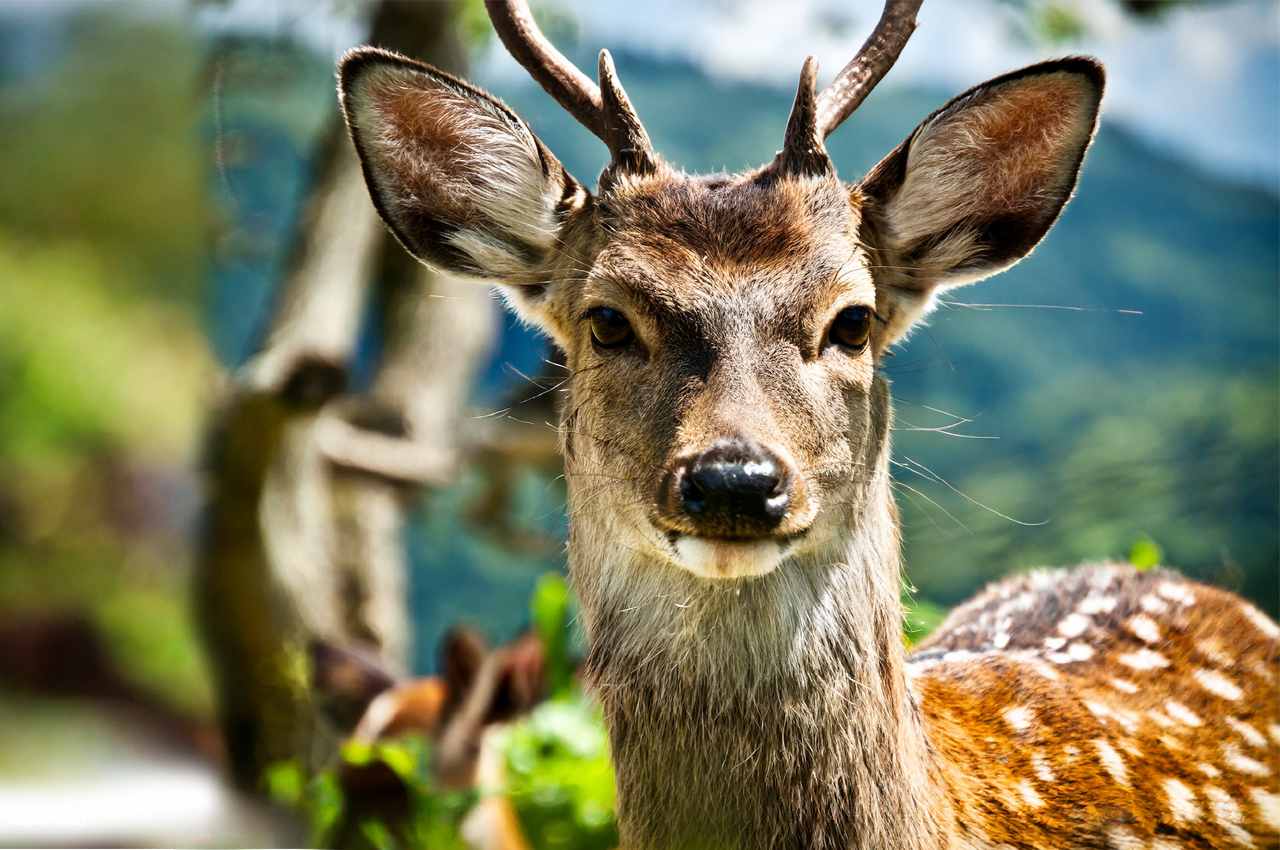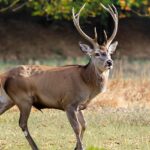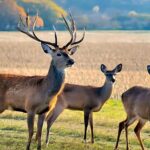Sika deer adaptations encompass both physical and behavioral traits. The remarkable herbivore sika deer, technically known as Cervus nippon, is known for its capacity to adapt to a variety of habitats. These deer have developed particular adaptations that enable them to flourish in a variety of habitats, and their natural range stretches from East Asia to imported populations in various different areas of the globe. We’ll look into their physical attributes, habitat preferences, behavioral traits, and the impact these adaptations play in their survival in this in-depth examination of sika deer adaptations.
Sika Deer Adaptations
Sika deer have a variety of adaptations that make it easier for them to live in their habitat. Here are some instances of how sika deer use their adaptations to survive in certain situations:
- Thick fur: To remain warm in the winter, sika deer utilize their thick fur. They disguise themselves from predators by using their fur as well.
- Long legs: Sika deer can sprint rapidly and flee from predators thanks to their lengthy legs. Their lengthy legs are also used for climbing and navigating over challenging terrain.
- Antlers and Sharp hooves: Sika deer have antlers that are powerful and pointed. They can climb and move across challenging terrain by using their pointed hooves and also use it to defend themselves from predators.
- Acute senses: Sika deer can locate predators and food through their sharp senses of sight, hearing, and smell. They converse with other herd members using their senses as well.
- Excellent swimmers: Sika deer can navigate water and flee from predators thanks to their prowess in the water.
- Diet: Sika deer adapt their diversified food to their habitat. Their food may consist of poison ivy, ground ferns, myrtle bushes, fallen leaves, trees, brushy vegetation, soybeans, and maize.
- Coat color: The sika deer’s coat color changes from reddish-brown in the summer to dark brown or black in the winter. Its rump is white, and it has white markings on its back.
- Vocalization: Sika deer are quite vocal and use at least ten distinct noises to communicate with one another. Adult males make a unique, high-pitched “bark” when scared to warn others of danger.
- Adaptation to forest environments: The sika deer’s great hearing, agility, and reliance on forested plants as diet imply that it is a cervid that has adapted to forests.
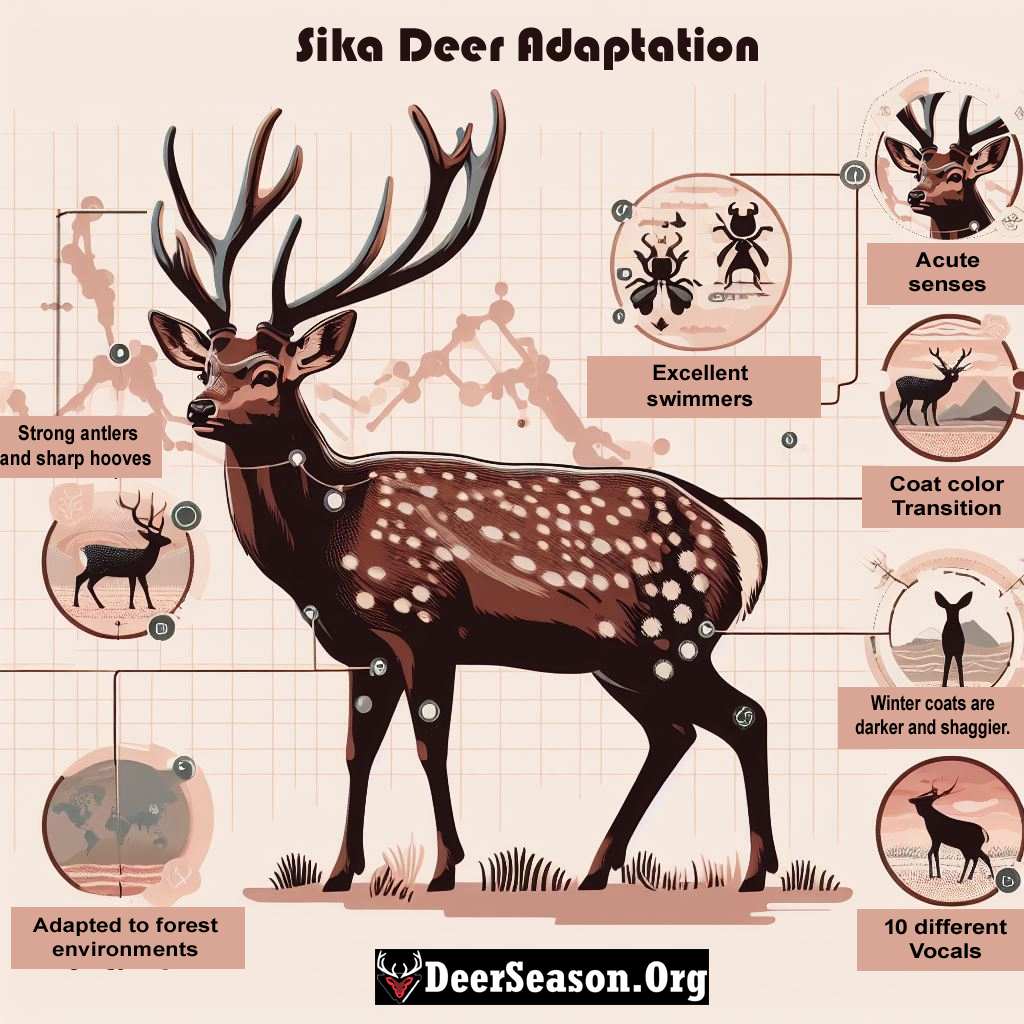
Sika deer live in herds of up to 20 and are gregarious. This social behavior helps to protect sika deer from predators and makes it easier for them to find food. In addition to these physical adaptations, sika deer also have a number of behavioral adaptations that help them to survive. For example, sika deer are very good at hiding and camouflage, which helps them to avoid predators.
- Crepuscular activity: Sika deer are most active in the early morning and late at night, when predator activity is at a minimum.
- Solitary behavior: The solitary nature of sika deer serves to lessen rivalry for food and mates.
- Cryptic coloration: The speckled fur of sika deer allows them to blend in with their environment and evade predators.
- Alarm calls: To alert other deer of danger, sika deer use a variety of alarm noises.
Sika deer are a highly adaptable species that have been successful in a wide range of environments, surviving in cold temperatures, challenging terrain, and the presence of predators.
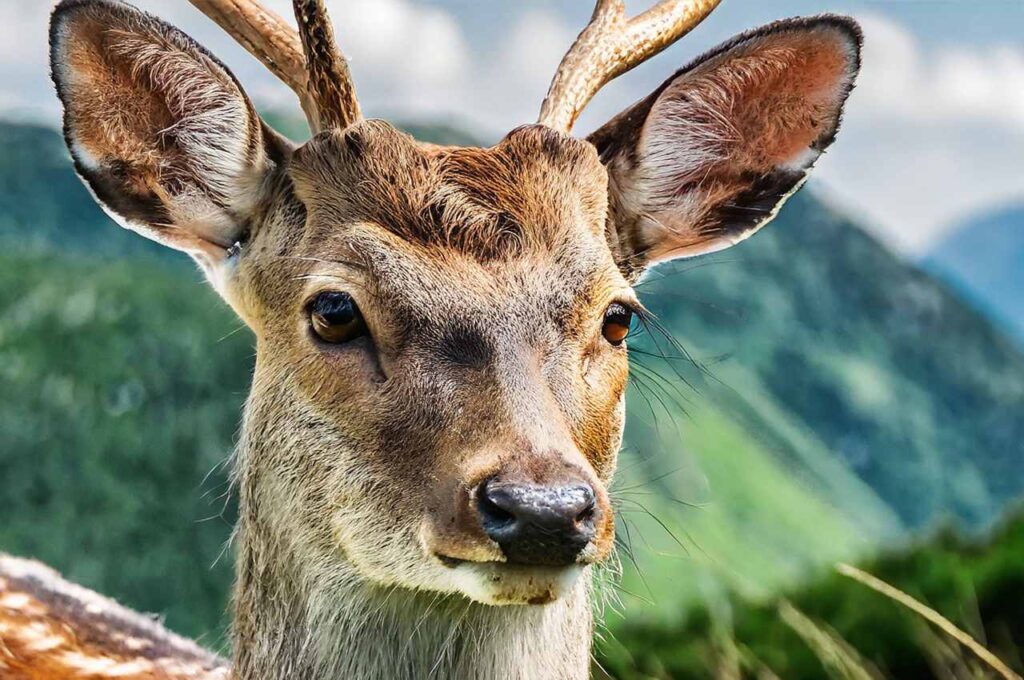
Sika Deer’s Distinctive Qualities
| Unique Features of Sika Deer | Description |
|---|---|
| Vocalization | Sika deer have a distinctive vocalization known as a "whistle" that they use to communicate with other herd members. |
| Social Behavior | Being very gregarious creatures, they may live in herds of up to 20 individuals. |
| Impressive Jumpers | Sika deer have extraordinary jumping prowess and can scale fences up to 10 feet tall. |
| Longevity in the Wild | Sika deer may live up to 20 years in their native environment. |
Physical Adaptations of Sika Deer
Let’s take a deeper look at these physical adaptations that Sika deer has in order to thrive in various habitats:
- Size and Weight: Sika deer range in height from 50 to 110 cm (20 to 43 inches) at the shoulder, with an average adult weight of around 42 kg (92 pounds), depending on the subspecies.
- Coat Color: Individuals of different subspecies exhibit striking differences in color, such as tan, black, gray, yellow-brown, or gray-brown. Some have spots, while others don’t. Their coat color ranges from chestnut-brown to reddish-olive.
- Body and Tail: All subspecies have small, wedge-shaped heads, compact bodies, and tiny legs. Their short tails range in length from 7.5 to 13 cm (3.0-5.1 inches).
- Antlers: Stags’ distinctive antlers, which are only seen on males, are strong, erect, and may vary in length from 28 to 80 cm (11 to 30 inches) depending on the subspecies.
- Sexual dimorphism: Antlers and bigger size make males stand out from females in the species.
- Lifespan: Sika deer have an average lifetime of 15 to 18 years in captivity, although they may live up to 25 years and 5 months in the wild.
| Subspecies | Height (at shoulder) | Weight (average adult) | Coat Color & Patterns | Antler Length (males) |
|---|---|---|---|---|
| Manchurian Sika | 50-110 cm (20-43 in) | 42 kg | Varied colors, with or without spots | 28-80 cm (11-30 in) |
| Dybowski's Sika (North) | Approximately 110 cm (40 in) | 110 kg (240 pounds) | Reddish brown with spots (summer), dark brown (winter) | > 85 cm (33 in) |
| Dybowski's Sika (South) | 80-86 cm (31-34 in) | 80 kg (180 pounds) | Reddish brown with spots (summer), dark brown (winter) | About 70 cm (28 in) |
Let’s now go more specific about the sika deer’s range and preferred habitats:
Distribution and Habitat of Sika Deer
The sika deer’s native range is vast, including areas like eastern Siberia, Japan, China, Taiwan, Korea, Manchuria, and parts of Vietnam. However, due to their adaptability and human introductions, sika deer are now found in many other parts of the world.
- Native Range: Their native range spans a variety of environments, from patchy clearings in woods, marshes, and wooded wetlands to temperate and subtropical forests in East Asia.
- Worldwide Introductions: Sika deer have been introduced in a number of nations and areas, including, for example, Australia, England, France, Maryland, Oklahoma, Poland, and New Zealand.
- Adaptability: Sika deer can live in areas with wide grasslands, especially those with extensive undergrowth that offers shelter and food sources. They do not exhibit a strong predilection for coniferous or deciduous woodlands.
- Home Range: Males and females have diverse home range characteristics, with males roaming over more expansive regions while females prefer to remain within a single area, which may be rather limited provided it offers acceptable habitat quality.
| Region | Native Range | Introduced Range | Preferred Habitat |
|---|---|---|---|
| Asia | China, Korea, Japan | Eastern Siberia, Taiwan, Vietnam, Manchuria | Temperate and subtropical forests |
| Worldwide Introduced | Australia, Europe, North America, etc. | Forests, woodlands, and clearings | |
| Environmental Factors | Forested areas, clearings, marshes | Diverse habitats with cover |
The sika deer’s behavioral traits are essential to their environment-specific adaption.
Behavioral Characteristics of Sika Deer
For a better understanding of the sika deer’s adaptability, let’s examine some of its behavioral characteristics:
- Nocturnal Behavior: Sika deer are predominantly nocturnal, meaning they are more active at night, however they may become more so in regions with considerable human activity in an effort to avoid people.
- Solitary Living: Sika deer tend to spend solitary lives, however they are not very social; during the mating season, females and their young often congregate in groups of two to three.
- Territorial Behavior: Male sika deer mark their borders by urinating in the holes they have dug with their forefeet and antlers to assert dominance and signal the presence of other males.
- Territorial conflicts: Males who are engaged in territorial conflicts may become combative with one another, using their hooves and antlers as their main weapons while running at medium speeds and doing remarkable jumps of up to three meters.
- Mating Strategies: This adaptation supports sika bucks’ reproductive success in varied situations by allowing them to mate with young hinds from closely related red deer populations in the absence of females of their own species.
| Behavior / Trait | Description |
|---|---|
| Social Structure | Solitary or in small groups; females may form groups with young during breeding season |
| Territorial Behavior | Males are territorial and use antlers to mark boundaries |
| Communication | Use at least ten different sounds, including bleats, whistles, and alarm barks |
| Defense Mechanisms | Strong antlers and sharp hooves; swift runners; good swimmers |
| Mating Behavior | Form harems during the rutting season; may mate with closely-related red deer |
| Activity Patterns | Mostly nocturnal; active during dawn and dusk |
Let’s now explore their eating patterns and the special characteristics that let them survive as herbivores:
Diet and Food Acquisition Adaptations
As with other deer species, sika deer are herbivores and eat a range of plant materials, which is essential for their habitat adaptability. Here are some important features of their diet and associated adaptations:
- Herbivorous Diet: Sika deer have a predominantly herbivorous diet, which includes leaves, roots, tubers, soft wood, bark, stems, seeds, grains, fruits, nuts, and even fungus.
- Dietary Flexibility: Because of their ability to digest fibrous plant materials, they have an advantage over other animals in that they can eat a range of forages, which allows them to adjust to the seasonal availability of food sources in various habitats.
The sika deer’s reproductive and life cycle adaptations are crucial for their survival in a variety of habitats:
Reproduction and Life Cycle
Let’s take a deeper look at how sika deer’s reproductive and life cycle traits contribute to their adaptability:
- Polygynous Breeding: During the rutting season, these deer engage in polygynous breeding, with the males keeping harems of many females.
- Gestation Period: Healthy does typically give birth to a single fawn after a gestation period of around seven months.
- Offspring Characteristics: A juvenile may weigh between 4.5 and 7 kg (9.9 and 15.4 lb) at birth, and the mother will care for it and nurse it for up to 10 months.
- Independence and Maturity: Both male and female juvenile deer attain sexual maturity at roughly 16 to 18 months of age, while the fawn, or baby deer, takes around 10 to 12 months to become independent and forage for their sustenance.
After looking at the sika deer’s physical characteristics, geographic range, and behavioral traits, let’s examine how they have adapted to their environment:
Sika Deer Environmental Adaptations
Sika deer have developed particular adaptations to deal with environmental difficulties in different environments.
- Swimming Capabilities: Sika deer are superb swimmers, rapidly diving into the water to escape predators, enabling them to move across habitats with water bodies and find extra food sources.
- Defense Mechanisms: Sika deer have robust antlers and razor-sharp hooves, which they often utilize as defensive mechanisms against predators. These modifications aid them in safeguarding both themselves and their offspring from predators.
- Seasonal Coat Changes: During the winter, sika deer experience changes in their coat, which thickens and gets rougher to help them stay warm and insulate themselves from the cold. Their coat also darkens to a gray-brown hue to help them absorb more sunlight.
Sika deer are renowned for their versatility and ability to thrive in a variety of habitats, yet they are also threatened and play important ecological roles:
Sika Deer in Ecosystems: Functions and Issues
Sika deer are important members of the ecosystems they live in because of their herbivorous lifestyle, which affects plant populations, and their interactions with predators and other species, which increase the complexity of the environment.
- Impact on Plant Populations: Sika deer’s eating habits have an impact on plant populations because they eat a variety of plant species, which alters the composition and distribution of vegetation in their surroundings.
- Interactions with Predators: They play a critical role in determining the dynamics of shared habitats, influencing the behavior and distribution of predators like wolves, bears, and tigers.
- Overpopulation: In certain areas, sika deer populations have expanded to the point where there is competition for resources and ecological imbalances.
- Hybridization: In regions where sika deer have been introduced, they have the potential to interbreed with indigenous species like red deer, endangering the genetic purity of local populations.
Conservation Status
- Sika deer confront overhunting, habitat degradation, and hybridization. Their worldwide rank is “least concern,” although regional and local status vary.
- Understanding sika deer adaptations is essential to understanding their biological complexity and ecological importance. Conservation is difficult because they must combine adaptation and environmental preservation. This requires constant research and control.
- Sika deer are fascinating examples of adaptability. Their adaptations in behavior, ecology, and physical traits demonstrate their resistance to environmental challenges. Although they flourish worldwide, it’s important to understand how their adaptation affects local ecosystems and apply conservation efforts to guarantee their growth.
Frequently Asked Questions
What are the key adaptations that allow Sika deer to thrive in various environments?
Sika deer have extraordinary adaptations that allow them to thrive in a variety of environments. For example, in northern deciduous forests, they rely on evergreen Sasa species as their main food source to survive harsh winters, while in southern evergreen forests, they adapt to a diet of fruits and seeds. Their adaptability in food choices and behavioral patterns helps them succeed in various conditions.
How do Sika deer adapt to snowy conditions?
In order to adapt, sika deer exhibit seasonal elevational movements depending on snow depth, develop thicker and rougher coats during the winter months to keep warm, and change their coat color to a dark grey-brown to absorb more sunlight, providing necessary insulation. Sika deer face challenges in snowy environments due to obstacles in locomotion and reduced food availability.
How do Sika deer protect themselves from predators?
Sika deer may be quick and nimble, making them tough targets for predators. They have also developed to numerous escape techniques, such as swimming when required, to elude dangers. Sika deer have robust antlers and pointed hooves that they employ for defense.
Are Sika deer good swimmers?
Swimming is one of Sika deer’s adaptive activities, which they employ to flee from predators or, when required, travel across bodies of water.
What is the primary adaptation that helps Sika deer survive the mating season and winter?
A larger body size and more fat deposits are beneficial for surviving the winter since these adaptations offer insulation and energy reserves. Sika deer exhibit seasonal behavioral changes, such as during mating season and overwintering.
Do Sika deer have any unique vocalizations, and how do they use them?
Sika deer are noted for their distinctive vocalizations, which are sometimes referred to as a “whistle.” These vocalizations are used to communicate with other herd members and are essential for social interactions and coordination within the herd.
What is the lifespan of Sika deer in the wild?
In the wild, sika deer may live up to 20 years, however this lifetime can change depending on the environment, food supply, and danger of predation.
How do Sika deer adapt to different forest types?
Sika deer are remarkably adaptable to different types of forest habitats; in northern deciduous forests, they depend on seasonal temperature changes and overwinter on evergreen Sasa species, whereas in southern evergreen forests, they adapt to a diet of fruits and seeds and live in smaller groups.
What makes the coat of Sika deer change color, and how does it aid in adaptation?
The Sika deer’s coat becomes dark grey-brown throughout the winter, which assists in adaption by enabling the deer to absorb more sunlight, which is necessary for remaining warm in chilly surroundings.
What are the key factors contributing to the adaptability of Sika deer in different regions of the world?
The habitat type, climate, and food supply all have an impact on how adaptive sika deer are; they may change their nutrition, behavior, and physical traits to survive in a variety of conditions.
Conclusion
Sika deer adaptations include their remarkable ability to thrive in diverse environments. In order to live, they have a variety of special traits, including as thick fur, long legs, keen vision and hearing, the capacity to swim, and a varied food. Additionally, sika deer have a variety of behavioral adaptations, including the ability to blend in with their surroundings and their shyness and caution. These adaptations enable sika deer in sheltering from danger and avoiding predators. In their natural habitat, sika deer contribute significantly to the ecology by dispersing seeds and regulating the development of plants. Additionally, sika deer are a well-liked game animal in several regions of the globe.
- California Deer Hunting Guide: Seasons, Rules, Permits, and More - 26 June 2024
- Arkansas Deer Season 2024 [Schedules, Licenses, Bag Limits & More!] - 26 June 2024
- 2024 Arizona Deer Season New Dates & Rules! - 25 June 2024
